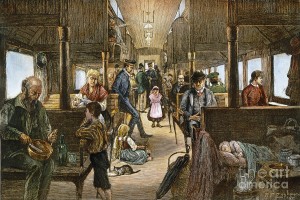By Elizabeth C. Goldsmith (Regular Contributor)
 One of the most beautiful and detailed travel accounts of a trip by railroad from the East to the West Coast in the nineteenth century was written by Robert Louis Stevenson. In 1879, the future author of Kidnapped and Treasure Island undertook his own adventurous voyage, from Scotland to San Francisco, in a romantic quest to join the lady of his dreams. Stevenson had met Fanny Osbourne in France and the two had fallen in love, despite obvious obstacles to the relationship – she was married, and ten years his senior. But when Stevenson received a letter from her
One of the most beautiful and detailed travel accounts of a trip by railroad from the East to the West Coast in the nineteenth century was written by Robert Louis Stevenson. In 1879, the future author of Kidnapped and Treasure Island undertook his own adventurous voyage, from Scotland to San Francisco, in a romantic quest to join the lady of his dreams. Stevenson had met Fanny Osbourne in France and the two had fallen in love, despite obvious obstacles to the relationship – she was married, and ten years his senior. But when Stevenson received a letter from her  indicating that she was about to be divorced, he decided to make the strenuous voyage to join her in California. His parents refused to pay, so he bought cheap passage on a boat to New Jersey and then a ticket on an “emigrant train” headed for the West Coast. By the time he reached America he was sick and exhausted. The remaining two-week trip to California almost killed him.
indicating that she was about to be divorced, he decided to make the strenuous voyage to join her in California. His parents refused to pay, so he bought cheap passage on a boat to New Jersey and then a ticket on an “emigrant train” headed for the West Coast. By the time he reached America he was sick and exhausted. The remaining two-week trip to California almost killed him.
Conditions on emigrant trains were difficult. The train made regular stops, three times a day, for food, but this meant that passengers had to rush to whatever eating establishment was closest to the train station and get back to the train car before it departed. Emigrant passengers were rarely given warning of the departing train. This meant that many often went without food, either from lack of money or lack of time.
 But Stevenson, remarkably, does not dwell on the punishing conditions of his voyage. Each time he does mention a missed meal or a paltry choice of inedible food, he seems to follow with a description of something beautiful. After reporting a day passed with no food at all, he switches to a description of the amazing richness of place names in America, and how they provide a writer with food for the imagination. “None can care for literature in itself who do not take a special pleasure in the sound of names; and there is no part of the world where nomenclature is so rich, poetical, humorous, and picturesque as the United States of America … The names of the states and territories themselves form a chorus of sweet and most romantic vocables: Delaware, Ohio, Indiana, Florida, Dakota, Iowa, Wyoming, Minnesota, and the Carolinas; there are few poems with a nobler music for the ear.”
But Stevenson, remarkably, does not dwell on the punishing conditions of his voyage. Each time he does mention a missed meal or a paltry choice of inedible food, he seems to follow with a description of something beautiful. After reporting a day passed with no food at all, he switches to a description of the amazing richness of place names in America, and how they provide a writer with food for the imagination. “None can care for literature in itself who do not take a special pleasure in the sound of names; and there is no part of the world where nomenclature is so rich, poetical, humorous, and picturesque as the United States of America … The names of the states and territories themselves form a chorus of sweet and most romantic vocables: Delaware, Ohio, Indiana, Florida, Dakota, Iowa, Wyoming, Minnesota, and the Carolinas; there are few poems with a nobler music for the ear.”
The vast plains of Nebraska were the least able to offer nourishment for his thoughts. The unchanging dullness of this landscape overwhelmed him: “Our consciousness, by which we live, is itself but the creature of variety. Upon what food does it subsist in such a land? What livelihood can repay a human creature for a life spent in this huge sameness?”
At the end of his voyage, Stevenson tells an anecdote that seems to sum up the strange mixture of brutality and nourishing hope that he had come to see as characterizing the experience of a newcomer to America. Seated at the end of a stifling railcar, he had propped the door open with his leg to get some air. A newsboy, annoyed by the encumbrance, kicked him and repeatedly jostled him as he continued to pass back and forth. Robert was feverish, and depressed by the lack of civility. “But suddenly I felt a touch upon my shoulder, and a large juicy pear was put in my hand. It was the newsboy, who had observed that I was looking ill and so made me this present out of a tender heart.”
Fanny Osbourne later wrote that her lover arrived in California barely alive. But she was the prize that assured his survival. They were married in San Francisco in May 1880. The newlyweds spent the summer, while Robert recovered his health, in a cabin in the abandoned Silverado mining camp, on the slope of Mount St. Helena.
For Further Reading:
Robert Louis Stevenson, From Scotland to Silverado. Ed. James D. Hart (Harvard University Press, 1966).

